Honeywell International Bundle
How did Honeywell International become a global powerhouse?
From its humble beginnings revolutionizing home comfort with thermostats, Honeywell International has transformed into a diversified technology and manufacturing titan. Its journey spans over a century, marked by groundbreaking innovations across multiple sectors. Discover the fascinating Honeywell International SWOT Analysis and explore its remarkable evolution from a heating systems innovator to a global leader.
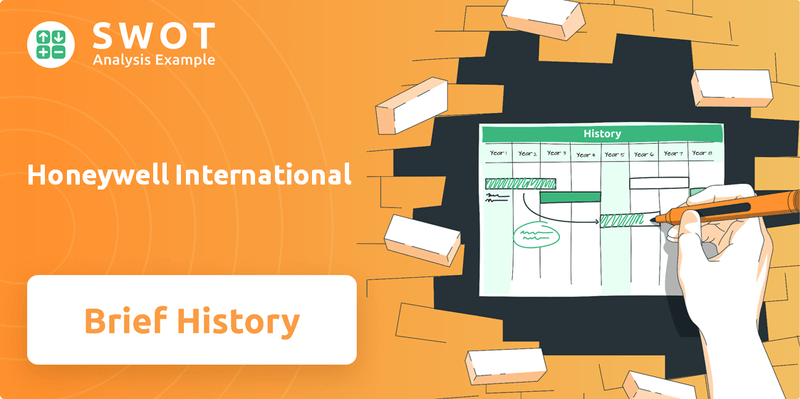
This exploration of the brief history of Honeywell International will delve into the early days of the Honeywell company, detailing its key milestones and major acquisitions. We'll examine Honeywell's technological advancements and its impact on the aerospace industry, building technologies, and automation. Furthermore, we'll analyze Honeywell's financial performance history and its current business segments, providing insights into its global presence and contributions to safety and innovation.
What is the Honeywell International Founding Story?
The story of Honeywell International begins in the late 19th century, evolving from a simple invention to a global technology and manufacturing leader. This journey, marked by innovation and strategic mergers, showcases the company's adaptability and enduring impact across various industries. Understanding the Marketing Strategy of Honeywell International provides insight into its sustained success.
The roots of what would become Honeywell International can be traced back to 1885. Albert Butz created the 'Damper Flapper,' a pioneering thermostat designed for coal furnaces. Although the patent was sold, it set the stage for future developments. This invention laid the groundwork for the Honeywell Heating Specialty Company.
Mark C. Honeywell established the Honeywell Heating Specialty Company in 1906 in Wabash, Indiana. His focus was to enhance hot water heat generators, addressing the need for more efficient heating solutions. This marked the formal beginning of the company's journey in the heating control market.
Honeywell's early years were characterized by innovation in heating control systems and strategic mergers.
- In 1927, the Honeywell Heating Specialty Company merged with the Minneapolis Heat Regulator Company.
- This merger combined crucial thermostat technologies.
- The original business model focused on manufacturing and supplying heating control systems.
- Honeywell's early success was built on addressing the growing demand for automated climate control.
A pivotal moment in the company's history was the 1927 merger between Honeywell Heating Specialty Company and Minneapolis Heat Regulator Company. This integration of thermostat technologies significantly strengthened its position in the heating control market. This strategic move enabled the company to leverage combined expertise and patents, setting a precedent for future growth through acquisitions. The primary focus of the business was the manufacturing and supply of heating control systems, a core product that met the rising demand for automated climate control in homes and buildings.
By the late 1920s, the merged company, Minneapolis-Honeywell Regulator Company, was well-positioned. This laid the foundation for its expansion into other sectors. The company's early success was driven by its ability to meet market demands for automated climate control, establishing a strong base for future growth and diversification.
Honeywell International SWOT Analysis
- Complete SWOT Breakdown
- Fully Customizable
- Editable in Excel & Word
- Professional Formatting
- Investor-Ready Format
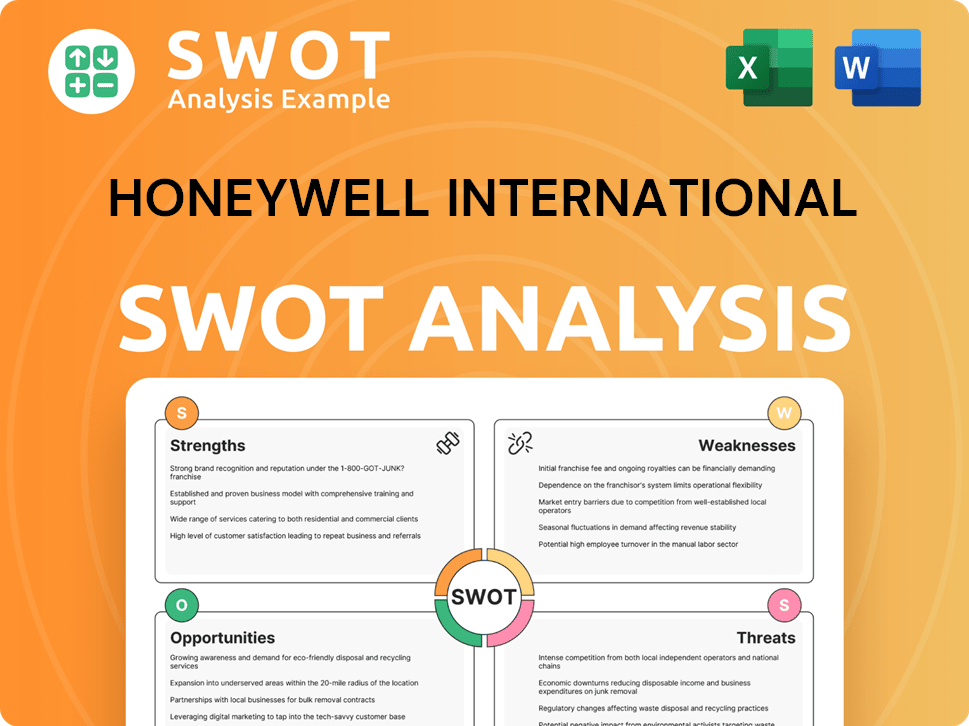
What Drove the Early Growth of Honeywell International?
The early growth of Honeywell International was marked by strategic mergers and acquisitions, which helped expand its product offerings and eliminate competitive patent advantages, particularly in the heating sector. Following a key merger in 1927, the company moved beyond simple heating controls. During World War II, the company became a significant defense contractor, gaining valuable expertise in advanced aerospace technologies. This period set the stage for the company to explore the aerospace and computer markets after the war.
In its recent growth phase, Honeywell has continued to broaden its global presence and capabilities through acquisitions and strategic realignments. The company has completed over 50 acquisitions, averaging nearly two annually over the past three years. These acquisitions have significantly boosted Honeywell's presence in aerospace, defense electronics, energy security, and sustainable solutions.
Notable acquisitions in 2023 and 2024 include Carrier's Global Access Solutions business for $5 billion (December 2023), CAES Systems Holdings for approximately $1.9 billion (September 2024), Air Products' LNG process technology and equipment business for $1.81 billion (September 2024), and Sundyne for $2.16 billion (March 2025). These acquisitions have bolstered Honeywell's presence in key sectors.
In the first quarter of 2025, Honeywell reported sales of $9.8 billion, an 8% increase from the same period last year, with organic sales growth of 4%. This growth was particularly driven by strong performance in its defense and space and building solutions segments. The company's backlog also grew by 8% excluding acquisitions.
Honeywell's strategic focus on three megatrends—automation, future aviation, and energy transition—has guided its recent growth efforts, allowing it to capture new market opportunities and enhance its technological leadership. The company continues to innovate and expand its global footprint. For more information about the company, you can read a brief history of Honeywell International.
Honeywell International PESTLE Analysis
- Covers All 6 PESTLE Categories
- No Research Needed – Save Hours of Work
- Built by Experts, Trusted by Consultants
- Instant Download, Ready to Use
- 100% Editable, Fully Customizable
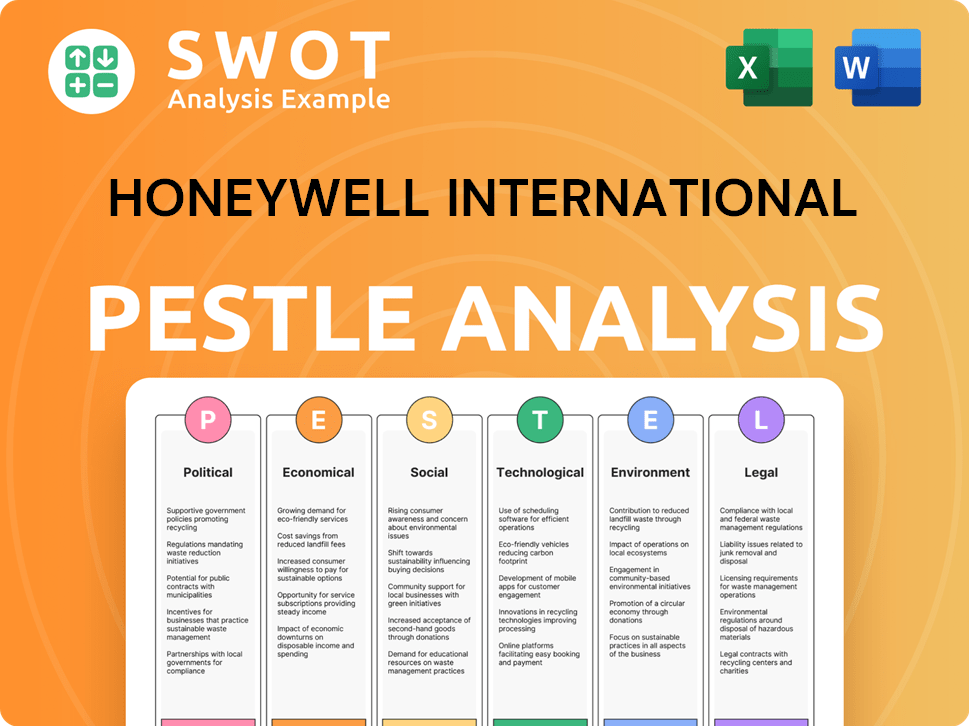
What are the key Milestones in Honeywell International history?
The brief history of Honeywell International is marked by significant achievements and strategic adaptations. From its early innovations to its current position as a global leader, the company has consistently evolved, responding to market dynamics and technological advancements. This evolution has shaped Honeywell's trajectory, making it a key player across various industries.
| Year | Milestone |
|---|---|
| Early 1900s | Founded as the Honeywell Heating Specialties Co., later merged with the Minneapolis Heat Regulator Company. |
| 1940s | Became a significant defense contractor during World War II, producing critical equipment. |
| 1960s | Developed thousands of parts for the Apollo Moon Mission, showcasing its technological capabilities. |
| 1999 | Merged with AlliedSignal, forming a diversified industrial conglomerate. |
| 2024-2025 | Announced strategic portfolio review, including plans to separate Automation and Aerospace Technologies businesses, and the spin-off of Advanced Materials. |
Honeywell has consistently pushed the boundaries of innovation. In 2024, the company invested over $2.3 billion in research and development, leading to the filing of over 1,500 patents. Recent advancements include AI-powered digital assistants for workers and new technologies for sustainable aviation fuel production.
The invention of the thermostat revolutionized heating control, a foundational innovation for the company. This early innovation set the stage for future technological advancements and product development.
Honeywell developed thousands of parts for the Apollo Moon Mission, demonstrating its expertise in aerospace technology. This involvement solidified its reputation for precision and reliability.
Honeywell became a major defense contractor during World War II, producing essential equipment for the war effort. This experience expanded its manufacturing capabilities and technological expertise.
Recent innovations include AI-powered digital assistants for workers, enhancing productivity and efficiency. These tools represent a step forward in automation and workforce support.
New technologies for sustainable aviation fuel production are part of Honeywell's commitment to environmental sustainability. This innovation supports the reduction of carbon emissions in the aviation industry.
Honeywell is also innovating in advanced barcode scanning with AI. This technology improves data capture and operational efficiency across various sectors.
Despite its successes,
Honeywell has navigated economic downturns by adapting its strategies and streamlining operations. These adjustments have allowed the company to remain competitive and resilient.
The company faces competition in various sectors, requiring continuous innovation and strategic positioning. Honeywell's focus on technology leadership and customer needs helps it to differentiate itself.
Honeywell has undertaken restructuring efforts to optimize its business structure and enhance strategic flexibility. These initiatives aim to unlock greater long-term value.
The ongoing portfolio review, including the planned separations of Automation and Aerospace Technologies businesses, is a key strategic move. These separations are expected to be completed in the second half of 2026 for Automation and Aerospace.
The implementation of the World Class Manufacturing (WCM) program at the Phoenix plant led to significant improvements, such as a 70% reduction in defects. This highlights the importance of empowering teams and effective communication in driving radical change.
Honeywell consistently undertakes strategic pivots to adapt to changing market conditions and technological advancements. These pivots ensure the company's continued relevance and growth.
Honeywell International Business Model Canvas
- Complete 9-Block Business Model Canvas
- Effortlessly Communicate Your Business Strategy
- Investor-Ready BMC Format
- 100% Editable and Customizable
- Clear and Structured Layout
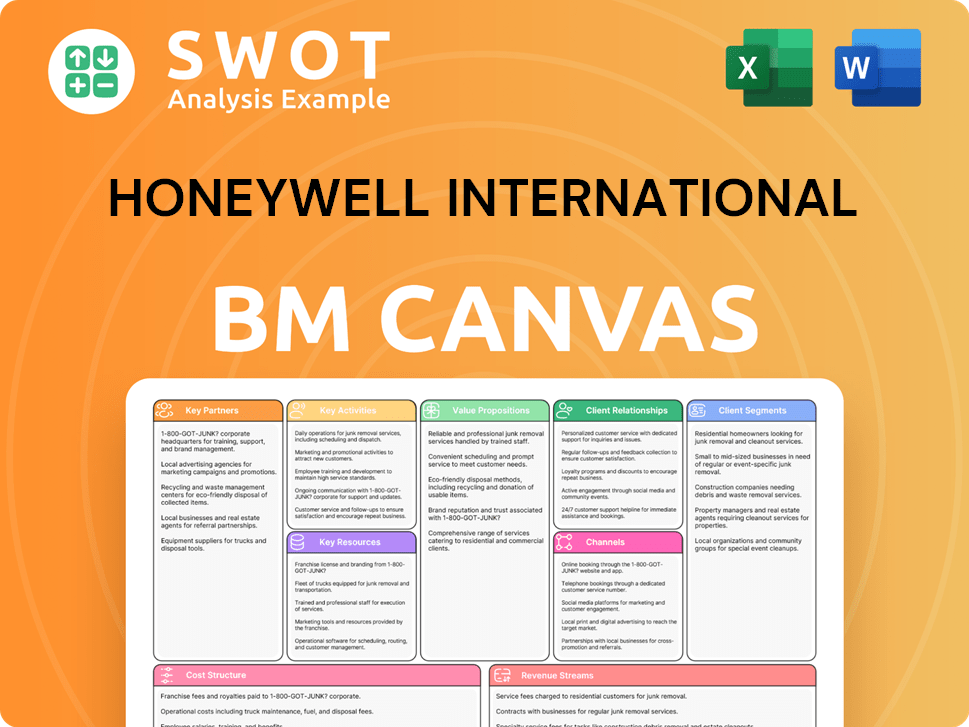
What is the Timeline of Key Events for Honeywell International?
The brief history of Honeywell International is a story of innovation and strategic adaptation, marked by significant milestones in its evolution. From its early days to becoming a global leader, the company has consistently pushed boundaries. Here's a look at the key moments in the Honeywell history.
| Year | Key Event |
|---|---|
| 1885 | Albert Butz invents the 'Damper Flapper' thermostat, setting the stage for climate control innovation. |
| 1906 | Mark C. Honeywell founds Honeywell Heating Specialty Company, marking the company's official beginning. |
| 1927 | Honeywell Heating Specialty Company merges with Minneapolis Heat Regulator Company, creating a new entity. |
| World War II | Became a major defense contractor, expanding its expertise in the aerospace industry. |
| Late 1980s/Early 1990s | Implemented the World Class Manufacturing program, significantly reducing defects and inventory. |
| December 2023 | Acquired Carrier's Global Access Solutions business for $5 billion, expanding its portfolio. |
| September 2024 | Acquired CAES Systems Holdings for approximately $1.9 billion, enhancing its technological capabilities. |
| September 2024 | Acquired Air Products' LNG process technology and equipment business for $1.81 billion. |
| November 2024 | Announced plans to spin off its Advanced Materials business, signaling strategic restructuring. |
| February 2025 | Announced plans to separate Automation and Aerospace Technologies businesses, aiming for increased focus. |
| March 2025 | Acquired Sundyne for $2.16 billion, broadening its industrial offerings. |
| Q1 2025 | Reported sales of $9.8 billion, up 8% year-over-year, with a backlog increase of 8% excluding acquisitions. |
Looking ahead, Honeywell International is strategically focused on automation, future aviation, and energy transition. These core areas are expected to drive growth and innovation. The company is positioning itself to capitalize on emerging opportunities within these sectors.
The planned separations of Advanced Materials, Automation, and Aerospace businesses are underway. These moves aim to create three independent, industry-leading public companies. This restructuring is designed to enhance strategic flexibility and capital allocation.
For 2025, Honeywell expects sales between $39.6 billion and $40.5 billion, with organic sales growth of 2% to 5%. Adjusted earnings per share are projected to be between $10.20 and $10.50. The company anticipates operating cash flow of $6.7 billion to $7.1 billion and free cash flow of $5.4 billion to $5.8 billion.
Honeywell is committed to deploying at least $25 billion towards high-return capital expenditures, dividends, and accretive acquisitions through 2025. The company is actively investing in AI-driven technologies and next-generation air mobility systems, which are expected to drive incremental revenue growth.
Honeywell International Porter's Five Forces Analysis
- Covers All 5 Competitive Forces in Detail
- Structured for Consultants, Students, and Founders
- 100% Editable in Microsoft Word & Excel
- Instant Digital Download – Use Immediately
- Compatible with Mac & PC – Fully Unlocked
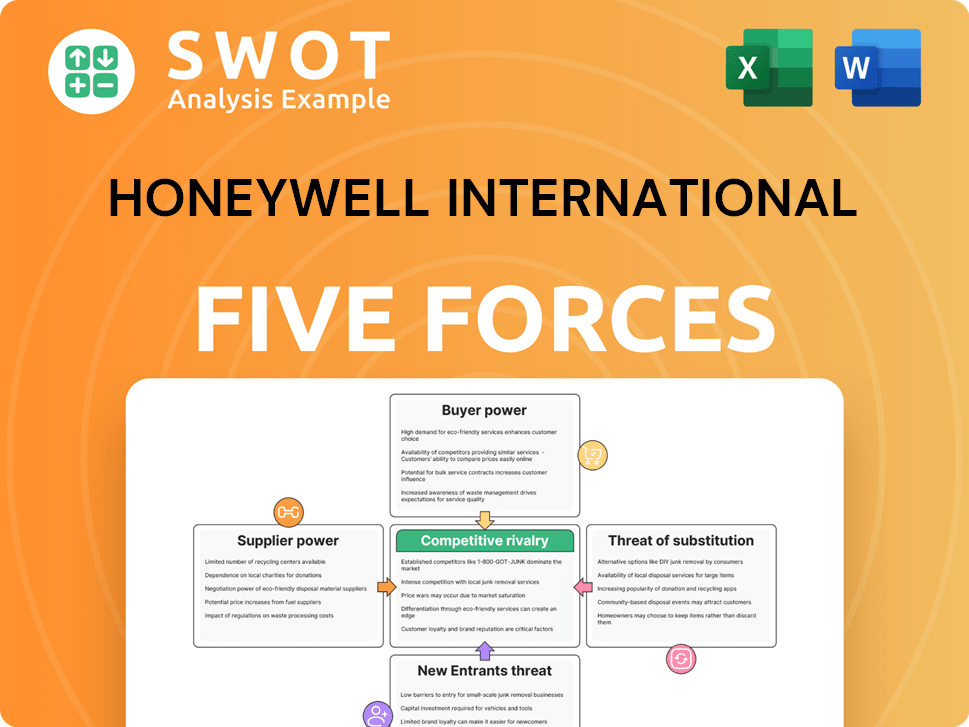
Related Blogs
- What is Competitive Landscape of Honeywell International Company?
- What is Growth Strategy and Future Prospects of Honeywell International Company?
- How Does Honeywell International Company Work?
- What is Sales and Marketing Strategy of Honeywell International Company?
- What is Brief History of Honeywell International Company?
- Who Owns Honeywell International Company?
- What is Customer Demographics and Target Market of Honeywell International Company?
Disclaimer
All information, articles, and product details provided on this website are for general informational and educational purposes only. We do not claim any ownership over, nor do we intend to infringe upon, any trademarks, copyrights, logos, brand names, or other intellectual property mentioned or depicted on this site. Such intellectual property remains the property of its respective owners, and any references here are made solely for identification or informational purposes, without implying any affiliation, endorsement, or partnership.
We make no representations or warranties, express or implied, regarding the accuracy, completeness, or suitability of any content or products presented. Nothing on this website should be construed as legal, tax, investment, financial, medical, or other professional advice. In addition, no part of this site—including articles or product references—constitutes a solicitation, recommendation, endorsement, advertisement, or offer to buy or sell any securities, franchises, or other financial instruments, particularly in jurisdictions where such activity would be unlawful.
All content is of a general nature and may not address the specific circumstances of any individual or entity. It is not a substitute for professional advice or services. Any actions you take based on the information provided here are strictly at your own risk. You accept full responsibility for any decisions or outcomes arising from your use of this website and agree to release us from any liability in connection with your use of, or reliance upon, the content or products found herein.